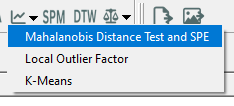Sift - Mahalanobis Distance Dialog: Difference between revisions
No edit summary |
No edit summary |
||
| Line 21: | Line 21: | ||
* '''Separate conditions in test:''' If conditions should be treated as separate groups. | * '''Separate conditions in test:''' If conditions should be treated as separate groups. | ||
* '''Auto-exclude results:''' If outliers should be automatically excluded from the results. | * '''Auto-exclude results:''' If outliers should be automatically excluded from the results. | ||
* '''High variability PC threshold:''' . | * '''High variability PC threshold:''' . | ||
* '''High variability P-Value:''' . | * '''High variability P-Value:''' . | ||
Revision as of 18:54, 2 April 2024
| Language: | English • français • italiano • português • español |
|---|
Mahalanobis Distance is a common measure used to determine outliers in a data sample. The Mahalanobis distance can be conceptualized as the distance of a point from the centroid of the data set onto an ellipse. The Mahalanobis distance method can be used on PCA results. This is done by measuring the distance of each point to the centroid in the transformed PCA space.
The Mahalanobis Distance is found on the toolbar and under 'Outlier Detecting Using PCA' in the Analysis menu.
Dialog

The Mahalanobis Distance using PCA allows the user to automatically search the data and identify traces that are outside the norm. The search for outliers can be done by Combined Groups, Group, and Workspaces. Users can decide if they want to auto-exclude any outliers that are detected in the groups or workspaces, and specify any thresholds and P-values of high, low, and combined variability.
- Combined group passes: The number of passes to make on the combined groups.
- Group passes: The number of passes to make on each group.
- Workspace passes: The number of passes to make on each workspace.
- Separate conditions in test: If conditions should be treated as separate groups.
- Auto-exclude results: If outliers should be automatically excluded from the results.
- High variability PC threshold: .
- High variability P-Value: .
- Low variability P-Value: .
- Combined variability P-Value : .
